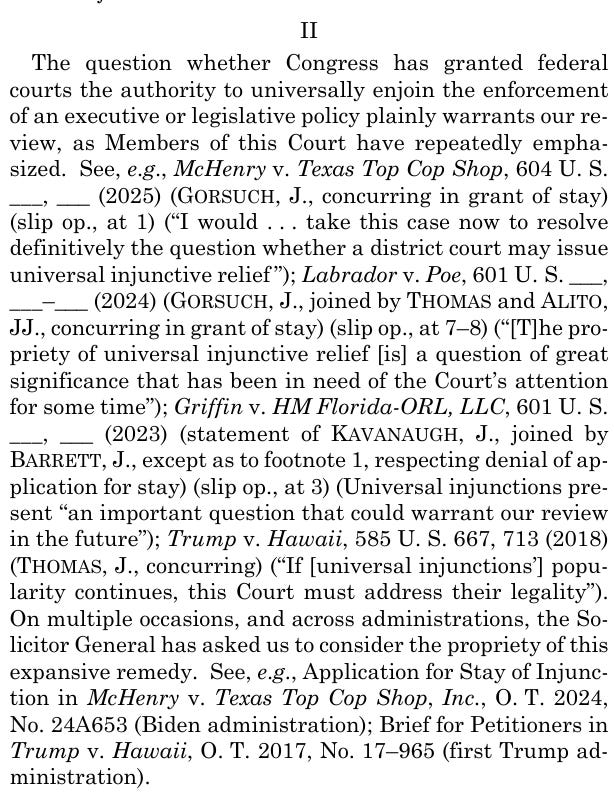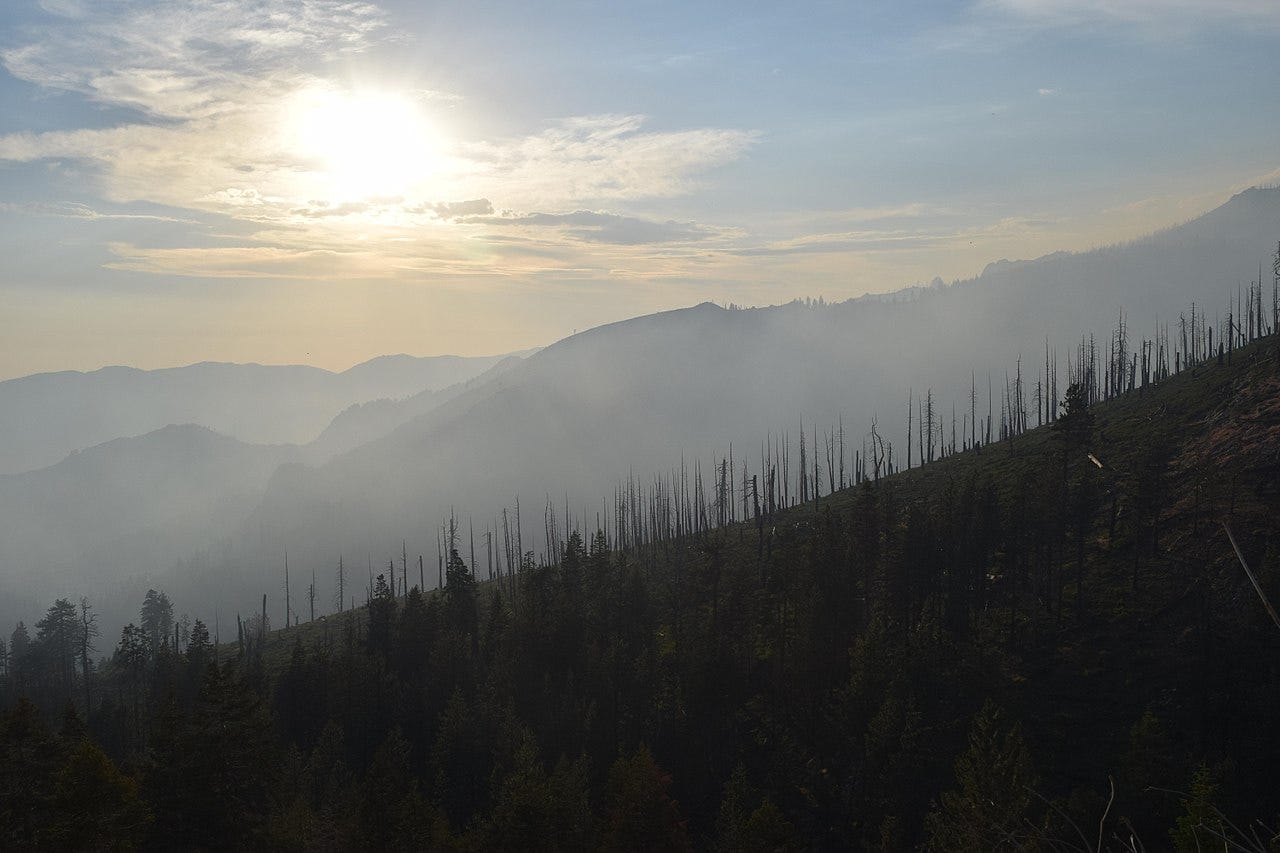Why Now? The Timing of the Universal Injunction Ruling
Over the weekend I felt like I was reading two different conversations about universal injunctions and the Court’s decision in Trump v. CASA. One was a conversation about technical legal issues — was the Court’s decision correct, what should we think about the subsequent questions of complete relief, class actions, APA vacatur, etc. The second one was a conversation about politics — doesn’t the Court realize that The Republic Is At Risk, etc.
One question that comes out of the second conversation is the question of timing. Why are universal injunctions only being held unlawful now, five months into the second Trump administration? Shouldn’t the Supreme have said they were also unlawful back when they were being used by various Texas district judges against President Biden?
As I discussed on the podcast last Friday, I think the answer to this is “yes!” But the timing and history are a little more complicated.
Indeed, I sometimes think about the briefing in Summers v. Earth Island Institute back in October Term 2008. Summers turned out to be a moderately important Article III standing case, but one of the other questions presented by the government — this was the George W. Bush administration — was “Whether the court of appeals erred in affirming the nationwide injunctions issued by the district court.”
The argument against the nationwide injunction was not as fully developed at the time, was not as categorical, and relied more heavily on the issue preclusion precedent of US v. Mendoza. But it was there, accompanied by a warning that this practice was just starting to grow in district courts in the Ninth Circuit.
I sometimes wonder what the past two decades of public law litigation would look like if the Court had chosen to resolve the case on nationwide injunction grounds rather than the Article III standing ground it chose. Much better, I think! But for whatever reason, the Court did not do that.
The nationwide injunction also became prominent during the last few years of the Obama administration when a Texas district court issued a nationwide injunction against the DAPA program. But this time, when the Obama administration petitioned for cert. they did not ask the Court to review the nationwide injunction issue. That turned out to be especially fateful when Justice Scalia died while the case was pending resulting in the injunction being affirmed by an equally divided court. But again I wonder what would have happened if the United States had petitioned on the issue and gotten five or more votes to limit the scope of the injunction even while affirming on the merits.
In any event, by the time of the first Trump administration and the Biden administration the Court was given several more chances to rule on the lawfulness of universal relief, and it declined to do so. But it’s worth noting that some of the Court’s most conservative Justices were probably ready to issue this kind of ruling earlier, including during the Biden administration.
So the question is why were they unable to find enough votes to do so until the second Trump administration?
One implied answer on the internet right now appears to be a cynical one: That the Court is trying to manipulate the timing of its rulings to help Republican presidents and not Democratic presidents. This is possible, of course. But the fact that there were already conservative justices trying to take this issue up years earlier makes it harder to believe, and requires a more complicated narrative. Also, on the purely cynical theory, it would still be a puzzle why the Court didn’t stop universal injunctions back during the first Trump administration.
This is all purely speculation on my part, but I would speculate that over the combined course of the first Trump administration and the Biden administration, as universal injunctions became more common it probably became clear to a super majority of the Court that something should be done about universal injunctions, but it was not clear what. There might have been 3-4 Justices who were fully convinced on purely formalist grounds that universal injunctions were illegal. But 2-3 other Justices (and at the time, Justice Kagan seemed plausibly likely to be among them) may have wanted to restrict universal injunctions but were not fully convinced that they were fully forbidden. Yet it is unclear how to say that, or even whether saying that would be productive without more of a worked-out theory.
So what changed? Again, this is just a guess, but my guess is that the first few months of the second Trump administration appeared to be kicking things into yet another gear, such that a majority of the Justices were finally convinced that the status quo was untenable, and that establishing a firm rule against universal injunctions (albeit a rule with caveats about complete relief, class actions, and maybe the APA) was better, even pragmatically, than continuing to say nothing. I’m sure one could make the case that political instincts were part of that judgment, but I don’t think a straightforwardly cynical narrative makes as much sense.
A related point — as some have observed, Justice Kagan appeared to a critic of universal injunctions during the late Biden administration, at least in her extrajudicial remarks, but then signed on to the principal dissent in Trump v. CASA without caveat. Is her behavior at least explained by the cynical narrative? I am skeptical here too. More plausibly, I think, Justice Kagan probably still believes that universal injunctions are generally problematic and should be disfavored, but perhaps still believes that they should not always be forbidden. And she might well think that CASA — for both practical and equitable reasons — is an especially good case for such an injunction, even if such injunctions are otherwise disfavored.
Again, I do agree with the basic criticism that it would have been better for the Court to issue a decision like Trump v. CASA earlier than it did, and also with the obvious response that even if this decision comes too late, that does not make it wrong. In my view the reasons why it took so long are somewhat complicated, involving the interactions of several different groups of Justices and the litigating choices and accidents of history along the way.





I'm not sure this discussion really addresses why the court wasn't interested in this when SG Prelogar was trying to repeated tee up this issue and was ignored.
Also there doesn't seem to be a good reason that the court couldn't have also decided the merits of CASA as well.
As many defenders of the CASA decision seem to be doing, it really looks like you are missing the forest for the trees. Any single decision can almost always be defended and explained, but there seems to be a pattern in the cases they choose, the way they choose to resolve them, the activity on the shadow docket (which is a great term since they refuse to write or explain anything there!), and their selected modes of analysis. I've heard you time and again say that you think it's good when people on the court explain themselves because it lets you know their thinking and helps you predict how they might think about issues in the future. I am, as yet, unconvinced that any of that analysis actually does a better job of prediction than partisan alignment (on cases where there is a clear partisan wedge).
This analysis completely ignores why there have been so many injunctions this year, and the purpose of injunctions. I'd say it's baffling, if I hadn't begun to finally understand that people in law see all this stuff as a silly intellectual game rather than what they really are - matters of life and death.